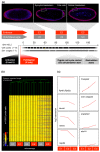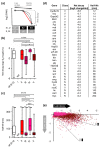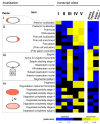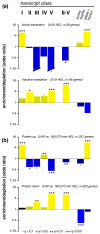Genome-wide analysis of mRNA decay patterns during early Drosophila development
- PMID: 20858238
- PMCID: PMC2965385
- DOI: 10.1186/gb-2010-11-9-r93
Genome-wide analysis of mRNA decay patterns during early Drosophila development
Abstract
Background: The modulation of mRNA levels across tissues and time is key for the establishment and operation of the developmental programs that transform the fertilized egg into a fully formed embryo. Although the developmental mechanisms leading to differential mRNA synthesis are heavily investigated, comparatively little attention is given to the processes of mRNA degradation and how these relate to the molecular programs controlling development.
Results: Here we combine timed collection of Drosophila embryos and unfertilized eggs with genome-wide microarray technology to determine the degradation patterns of all mRNAs present during early fruit fly development. Our work studies the kinetics of mRNA decay, the contributions of maternally and zygotically encoded factors to mRNA degradation, and the ways in which mRNA decay profiles relate to gene function, mRNA localization patterns, translation rates and protein turnover. We also detect cis-regulatory sequences enriched in transcripts with common degradation patterns and propose several proteins and microRNAs as developmental regulators of mRNA decay during early fruit fly development. Finally, we experimentally validate the effects of a subset of cis-regulatory sequences and trans-regulators in vivo.
Conclusions: Our work advances the current understanding of the processes controlling mRNA degradation during early Drosophila development, taking us one step closer to the understanding of mRNA decay processes in all animals. Our data also provide a valuable resource for further experimental and computational studies investigating the process of mRNA decay.
Figures










Similar articles
-
Dynamic regulation of mRNA decay during neural development.Neural Dev. 2015 Apr 21;10:11. doi: 10.1186/s13064-015-0038-6. Neural Dev. 2015. PMID: 25896902 Free PMC article.
-
Measuring mRNA stability during early Drosophila embryogenesis.Methods Enzymol. 2008;448:299-334. doi: 10.1016/S0076-6879(08)02616-5. Methods Enzymol. 2008. PMID: 19111183
-
Maternal mRNA deadenylation and decay by the piRNA pathway in the early Drosophila embryo.Nature. 2010 Oct 28;467(7319):1128-32. doi: 10.1038/nature09465. Epub 2010 Oct 17. Nature. 2010. PMID: 20953170 Free PMC article.
-
Functions of microRNAs in Drosophila development.Biochem Soc Trans. 2010 Aug;38(4):1137-43. doi: 10.1042/BST0381137. Biochem Soc Trans. 2010. PMID: 20659018 Review.
-
The mother-to-child transition.Dev Cell. 2007 Jun;12(6):847-9. doi: 10.1016/j.devcel.2007.05.009. Dev Cell. 2007. PMID: 17543857 Review.
Cited by
-
Molecular changes during egg activation.Curr Top Dev Biol. 2013;102:267-92. doi: 10.1016/B978-0-12-416024-8.00010-6. Curr Top Dev Biol. 2013. PMID: 23287037 Free PMC article. Review.
-
A spatiotemporally resolved atlas of mRNA decay in the C. elegans embryo reveals differential regulation of mRNA stability across stages and cell types.bioRxiv [Preprint]. 2024 Jan 16:2024.01.15.575757. doi: 10.1101/2024.01.15.575757. bioRxiv. 2024. Update in: Genome Res. 2024 Sep 20;34(8):1235-1252. doi: 10.1101/gr.278980.124. PMID: 38293118 Free PMC article. Updated. Preprint.
-
Dynamic regulation of mRNA decay during neural development.Neural Dev. 2015 Apr 21;10:11. doi: 10.1186/s13064-015-0038-6. Neural Dev. 2015. PMID: 25896902 Free PMC article.
-
Continuous transcriptome analysis reveals novel patterns of early gene expression in Drosophila embryos.Cell Genom. 2023 Feb 15;3(3):100265. doi: 10.1016/j.xgen.2023.100265. eCollection 2023 Mar 8. Cell Genom. 2023. PMID: 36950383 Free PMC article.
-
Translational Control during Developmental Transitions.Cold Spring Harb Perspect Biol. 2019 Jun 3;11(6):a032987. doi: 10.1101/cshperspect.a032987. Cold Spring Harb Perspect Biol. 2019. PMID: 30082467 Free PMC article. Review.
References
Publication types
MeSH terms
Substances
Grants and funding
LinkOut - more resources
Full Text Sources
Molecular Biology Databases

